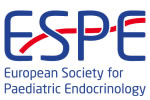hrp0082p1-d2-219 | Reproduction (1) | ESPE2014
Mutation Analysis of the KISS1, KISS1R, LIN28A, LIN28B, TAC3, and TACR3 Genes in Girls with Central Precocious Puberty
Kim Yoo-Mi , Hye Kim Ja , Hyang Cho Ja , Choi Jin-Ho , Yoo Han-Wook
hrp0082p2-d1-520 | Pituitary | ESPE2014
Hypothalamic Obesity in Children with Craniopharyngioma: Prevalence and Risk Factors of Obesity and Longitudinal Trends of BMI
Cho Ja Hyang , Kim Ja Hye , Kim Yoo-Mi , Choi Jin-Ho , Yoo Han-Wook
hrp0084p2-287 | Diabetes | ESPE2015
Incidence of Type 1 Diabetes among Korean Children and Adolescents in 2012–2013: Analysis of Data from the Nationwide Registry of Korea
Kim Jae Hyun , Lee Young Ah , Yang Sei Won , Shin Choong Ho
hrp0084p2-545 | Puberty | ESPE2015
Change of Growth Pattern and Bone Mineral Density in Ovariectomised Female Rats According to Oestrogen Dosage
Kang Byung Ho , Park Mun Suk , Yang You Jung , Lim Sung Jig , Shim Kye Shik
hrp0084p3-1106 | Pituitary | ESPE2015
Acquired Long QT Syndrome in a 14-year-old Boy with Panhypopituitarism
Kim Yoo-Mi , Seo Jung-Ho , Cheon Chong Kun , Yim Young-Tak , Kim Su Young
hrp0097p1-229 | Diabetes and Insulin | ESPE2023
Trajectories of glycemic control in transition-aged patients with type 1 diabetes
Jee Kim Min , Jeong Lee Yun , Ho Shin Choong , Ah Lee Young
hrp0097p2-62 | Diabetes and Insulin | ESPE2023
Growth patterns according to glycemic control, CGM apply, and diabetic complications in type 1 diabetes mellitus patients
Suh Junghwan , Kim Sujin , Lee Myeongseob , Song Kyungchul , Kwon Ahreum , Wook Chae Hyun , Kim Ho-Seong
hrp0092p1-103 | Pituitary, Neuroendocrinology and Puberty | ESPE2019
A Case of Panhipopituitarism with SOX3 Gene Deletion
Cinaz Peyami , Kayhan Gülsüm , Döğer Esra , Uğurlu Aylin Kılınç , Akbaş Emine Demet , Küpçü Zekiye , Perçin Ferda , Bideci Aysun , Çamurdan Orhun
hrp0089p1-p231 | Sex Differentiation, Gonads and Gynaecology or Sex Endocrinology P1 | ESPE2018
Altered Vascular Function in Boys with Hypospadias – Role of Reactive Oxygen Species
Lucas-Herald Angela K , Alves-Lopes Rheure , Haddow Laura , O'Toole Stuart , Basith Amjad S , Flett Martyn , Steven Mairi , Lee Boma , Montezano Augusto C , Faisal Ahmed Syed , Touyz Rhian M.
hrp0094fc6.2 | Bone and Mineral Metabolism | ESPE2021
Long-term effectiveness of PTH(1-34) infusion therapy for autosomal dominant hypocalcaemia type 1.
Sastre Ana , Valentino Kevin , Hannan Fadil M , Lines Kate E , Gluck Anna K , Stevenson Mark , Ryalls Michael , Gorrigan Rebecca , Pullen Debbie , Buck Jackie , Sankar Sailesh , Allgrove Jeremy , Thakker Rajesh V , Gevers Evelien F ,



